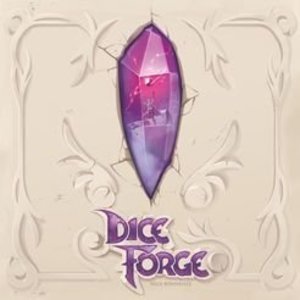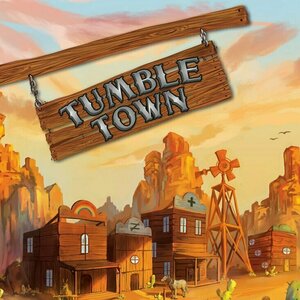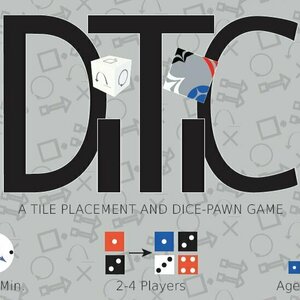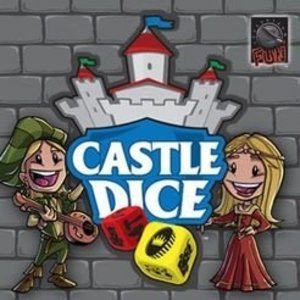Search
Purple Phoenix Games (2266 KP) rated Cooking Customers in Tabletop Games
Feb 4, 2020
Raise your hand if you have ever worked in the food industry. Okay, I see a few hands. Now raise your hand if you have ever been so torqued by a customer that you wanted to cook them in a pie. Oh, thanks for your hand Mrs. Lovett. Good to know. Well this game is an experience of getting your money and getting out. Fastest one to do so will win, and if you have to stew a few eyeballs in the process, more power to you.
DISCLAIMER: We were provided a copy of this game for the purposes of this review. This is a retail copy of the game, so what you see in these photos is exactly what would be received in your box. I do not intend to cover every single rule included in the rulebook, but will describe the overall game flow and major rule set so that our readers may get a sense of how the game plays. For more in depth rules, you may purchase a copy online or from your FLGS. -T
Cooking Customers is a card and dice game where the first player to amass $20 in “tips” will be crowned the winner. Players earn tips by serving enough meals to customers at each table. Players can receive meals by rolling them on dice, or by card manipulation. Let me explain.
To setup, place the meals (black discs) in the middle of the table for all to reach. Similarly, place all the dice nearby. These dice have three sides: FIRED, MEAL, and a blank side. Shuffle the mighty deck of cards and deal five to each player, placing the rest of the deck in the middle of the table. Finally, shuffle the Table cards and place somewhere near the other components. Players are now ready to begin!
On a player’s turn, they will first draw the topmost Table card to be placed in front of themselves. This card will show how many meals need to be served to it to be satisfied and earn tips. The Table cards will mostly just sit there in front of players collecting meal discs for the game’s duration. Once a Table card is drawn (and only one Table per player, please) the active player may then play cards from hand. A player may play one or two cards, but only one card may be played to the active player’s tableau, and only one card may be played on an opponent. Should a player not wish to play a card to anyone’s tableau, they must discard a card to the middle of the table. Then the active player will draw back to the hand size of five cards.
Cards played to other players are usually bad, Munchkin-esque cards that halt progression or just cause mayhem for their designs. I will not go into detail on these, as half the fun of this game is the Take-That of these cards. Cards played to a player’s own tableau can be a myriad choices: Cooks, Helpers, Kitchen Supplies, etc. The most important are the Cook cards. A player will need to have a Cook “hired” in front of them in order to participate in the next phase of the game: rolling dice. Players can have Helper cards (sous chefs) and Kitchen Supplies active without a Cook, but the player may not roll dice or serve meals without a Cook. Cooks and Helpers will dictate how many dice are rolled in the next phase of a turn, and rolling more dice is always better.
Once all cards have been played on a player’s turn, they may now roll the dice (though for a game with such a dark theme I say we use the “Roll Them Bones” colloquialism). When the dice are rolled, players are hoping for MEAL to show up on all dice. This is how a meal can be collected and served to the Table cards. However, if at any time all dice read FIRED then the player’s Cook is fired and they may not continue rolling dice. The Cook is discarded and play is forfeited to the next player. #cheflife amirite?
Once a Table card has all the meals it needs to be satisfied, the player may score it by flipping it over to reveal the amount in tips they have earned. Play continues in this fashion until one player has earned $20 in tips. They can then taunt the other players with their superiority.
Components. Cooking Customers is a BUNCH of cards, some painted wooden discs, and some embossed dice. The cards are good quality, the discs are good as well, and the dice are great. All the components are pretty darn good. The art, though gross at times, is really well-done (see what I did there) and kept us laughing throughout our plays.
I do have one qualm about this game: the rulebook. Though only six pages long and with lots of illustrations throughout, I found that reading it made me more confused than it should have. I did take the rulebook’s advice to go to the publisher’s website, goodenoughgames.com, and watch the rules explanation and playthrough. That helped immensely to clear up what the rulebook did to my brain.
All in all, we had a great time playing this one. We all like Munchkin, and though it is NOT Munchkin, Cooking Customers delivers a take-that dice and card game that really is worth checking out. If you are looking for something with a new theme that plays quickly and has some meat on its bones (and there), then we certainly recommend Cooking Customers. Purple Phoenix Games gives this one a hearty (food puns are too easy) 13 / 18. You can purchase a copy at goodenoughgames.com currently. While you’re there please watch the video.
DISCLAIMER: We were provided a copy of this game for the purposes of this review. This is a retail copy of the game, so what you see in these photos is exactly what would be received in your box. I do not intend to cover every single rule included in the rulebook, but will describe the overall game flow and major rule set so that our readers may get a sense of how the game plays. For more in depth rules, you may purchase a copy online or from your FLGS. -T
Cooking Customers is a card and dice game where the first player to amass $20 in “tips” will be crowned the winner. Players earn tips by serving enough meals to customers at each table. Players can receive meals by rolling them on dice, or by card manipulation. Let me explain.
To setup, place the meals (black discs) in the middle of the table for all to reach. Similarly, place all the dice nearby. These dice have three sides: FIRED, MEAL, and a blank side. Shuffle the mighty deck of cards and deal five to each player, placing the rest of the deck in the middle of the table. Finally, shuffle the Table cards and place somewhere near the other components. Players are now ready to begin!
On a player’s turn, they will first draw the topmost Table card to be placed in front of themselves. This card will show how many meals need to be served to it to be satisfied and earn tips. The Table cards will mostly just sit there in front of players collecting meal discs for the game’s duration. Once a Table card is drawn (and only one Table per player, please) the active player may then play cards from hand. A player may play one or two cards, but only one card may be played to the active player’s tableau, and only one card may be played on an opponent. Should a player not wish to play a card to anyone’s tableau, they must discard a card to the middle of the table. Then the active player will draw back to the hand size of five cards.
Cards played to other players are usually bad, Munchkin-esque cards that halt progression or just cause mayhem for their designs. I will not go into detail on these, as half the fun of this game is the Take-That of these cards. Cards played to a player’s own tableau can be a myriad choices: Cooks, Helpers, Kitchen Supplies, etc. The most important are the Cook cards. A player will need to have a Cook “hired” in front of them in order to participate in the next phase of the game: rolling dice. Players can have Helper cards (sous chefs) and Kitchen Supplies active without a Cook, but the player may not roll dice or serve meals without a Cook. Cooks and Helpers will dictate how many dice are rolled in the next phase of a turn, and rolling more dice is always better.
Once all cards have been played on a player’s turn, they may now roll the dice (though for a game with such a dark theme I say we use the “Roll Them Bones” colloquialism). When the dice are rolled, players are hoping for MEAL to show up on all dice. This is how a meal can be collected and served to the Table cards. However, if at any time all dice read FIRED then the player’s Cook is fired and they may not continue rolling dice. The Cook is discarded and play is forfeited to the next player. #cheflife amirite?
Once a Table card has all the meals it needs to be satisfied, the player may score it by flipping it over to reveal the amount in tips they have earned. Play continues in this fashion until one player has earned $20 in tips. They can then taunt the other players with their superiority.
Components. Cooking Customers is a BUNCH of cards, some painted wooden discs, and some embossed dice. The cards are good quality, the discs are good as well, and the dice are great. All the components are pretty darn good. The art, though gross at times, is really well-done (see what I did there) and kept us laughing throughout our plays.
I do have one qualm about this game: the rulebook. Though only six pages long and with lots of illustrations throughout, I found that reading it made me more confused than it should have. I did take the rulebook’s advice to go to the publisher’s website, goodenoughgames.com, and watch the rules explanation and playthrough. That helped immensely to clear up what the rulebook did to my brain.
All in all, we had a great time playing this one. We all like Munchkin, and though it is NOT Munchkin, Cooking Customers delivers a take-that dice and card game that really is worth checking out. If you are looking for something with a new theme that plays quickly and has some meat on its bones (and there), then we certainly recommend Cooking Customers. Purple Phoenix Games gives this one a hearty (food puns are too easy) 13 / 18. You can purchase a copy at goodenoughgames.com currently. While you’re there please watch the video.
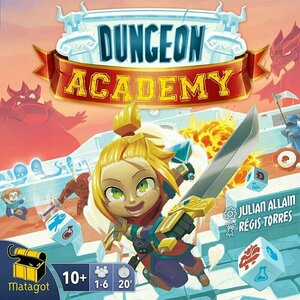
Dungeon Academy
Tabletop Game
Time to enter a dungeon — a dungeon composed of dice! — to kill monsters and score as much as...
Lumos (380 KP) rated Dice Forge in Tabletop Games
Mar 19, 2018
This game is really unique. I enjoy deck builders and dice games and this combines the two. Instead of building a deck of cards, however, you are altering the faces of a pair of dice to accumulate resources and take actions. I like that you gather resources on all players' turns because it allows you to have enough to do on your turn. This is a competitive game, however there is little you can do that will really hinder anther player's game play. There are some "attacks" but they are more little setbacks for the other player rather than total game changers. Overall, I think this is a really fun game. It takes a little playing before you get the hang of how to change the die faces, but it is really pretty easy once you get it together. I also like the fact that it is a fast game. Since all players are rolling during all the turns, you aren't really waiting for your turn, which is nice.
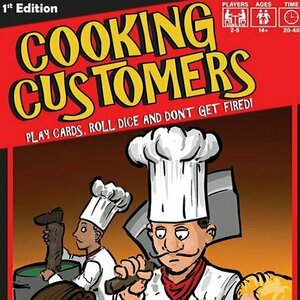
Cooking Customers
Tabletop Game
Play cards, roll dice and don't get fired! In Cooking Customers you will need to hire cooks to...
Purple Phoenix Games (2266 KP) rated Tumble Town in Tabletop Games
Mar 5, 2020
Fun fact about me: I used to live in Le Claire, Iowa (birthplace of “Buffalo Bill” Cody) on a street named Wild West Drive. While the town named many of their streets after American West figures and items, it was not your typical Iowa ghost town – if there are such things. That said, I do have an affinity for the Wild West in my gaming preferences, so when I heard about a dice/building game with an American West theme designed by Kevin Russ (who also recently designed Calico) I was immediately interested. But how does this one… stack up?
Tumble Town is dice rolling, structure building, drafting game with variable player powers. You are charged with choosing building plans to be added to Main Street of Tumble Town. You do this throughout the game by selecting the plans that will make best use of the resources (dice) you gain. The buildings that you construct may allow you special powers to be used on future turns, or one-time bonuses to be used once built. The player who can turn the greatest profit (in terms of VP) at the end of the game will be the winner!
DISCLAIMER: We were provided a prototype copy of this game for the purposes of this review. These are preview copy components, and the final components will definitely be different from these shown. Also, it is not my intention to detail every rule in the game, as there are just too many. You are invited to back the game through the Kickstarter campaign, from your FLGS, or through any other retailers stocking it after fulfillment. -T
To setup, deal each player a packet of starting components: a unique Horse card, two reference cards, Storehouse card, Main Street card, and two brown (they are red in the prototype) dice to be rolled and placed within the Storehouse. Shuffle and display the 1-, 2-, and 3-cactus building cards per the rulebook instructions to form the market. Set aside a number of each die type per the rulebook (both the building cards and dice are determined by number of players). Determine the first player and give them the first player token (a colorful rubber potted cactus). Players will connect their two Main Street cards at the central icon to create a two-card street (we chose the wagon wheel – Easy) and the game can begin!
Turns in Tumble Town consist of four mini-phases that flow into each other rather naturally. The first phase will have the players choosing a revealed building plan card from the offer market. The face-down draw stack will inform the active player as to how many and which type of dice they must draw and roll. Once they have these dice in their Storehouse, the player may now build plans using the dice they control. Buildings can be constructed and placed right onto Main Street, or be placed on the plan card to be placed on Main Street on a later turn. If the player has collected more dice than their Storehouse can hold, they must discard any of the dice they wish. This concludes a turn and the next player can begin their turn.
Certain iconography on the building plan cards allow players to use special powers throughout the game once built, and there are three types. Cards with the silvery bottom panel of symbols and the 1x notation are powers that must be used only once and only when the building is constructed. These powers could be collecting a die of the player’s choice, or receiving various dice counters. The building plan cards that feature a circular arrow notation are powers that can be used once per turn, every turn, if wished. These powers are found on each player’s Horse as well and can be adjusting a die’s face value, or re-rolling two dice, as examples. The third type of power is from the golden paneled cards that have an arrow pointing to a vertical line. These powers are only activated at the end of the game and mostly include scoring variances, like 1VP for each building a player has constructed that has a vulture icon (or a windmill, for example) featured on the card art.
Once a building is erected, the player may choose to place it onto their Main Street cards. When they place them, the player will need to choose where on Main Street these buildings should live. Like Bob Ross always says, “There are no mistakes, just happy accidents.” A player can place their buildings anywhere they wish on Main Street, but the Main Street cards will give extra bonuses to those players who plan ahead and place their buildings strategically. Some plots will ask for a building of a specific height (one die high or three dice high). Some will ask for the base level of the structure to be made of a specific material/die color (brown wood, black coal, silver metal, and gold… gold). Extra points are awarded if one-die-width alleyways are allotted, and these Main Street placements can score a bunch of endgame points.
Turns can be very quick or very deliberate, depending on the types of players involved. AP-prone players will take longer on their turns as they internalize all possibilities of their rolled results, while people like me just fly by the seats of our breeches. The game continues in this fashion: four mini-phases of drafting cards from the market, grabbing the associated dice, rolling them, and attempting to erect the best buildings on Main Street until two dice pools contain two or fewer dice. The current turn order finishes and the game is over.
Components. Again, this is a prototype copy of the game, and the publisher was decent enough to include a listing of items to be improved in the final version (like the red dice being poured brown in final – that really messed up someone’s strategy during a play-through for us because they kept forgetting that red is actually brown). The overall art style is very simplistic and I do NOT mean that negatively. The graphics and artwork are great, and give exactly what is needed without being so distracting that you cannot concentrate on your strategy. The dice are normal dice quality (that always seem to roll poorly when I’m rolling… hmm…). Once you see the photos of how the game will look during production, you will appreciate how great this is going to look on the table. No problems with components at all, save for the red vs. brown debacle that happened on our table. I really hope they keep the awwwwesome rubber cactus first player marker because it’s amazing.
I absolutely loved this one. I have always enjoyed using items for purposes other than originally intended – in this case, using dice as building materials. Of course, playing any game with dice introduces a bit of luck and instability in strategy, but Tumble Town offers quite a bit of manipulation of dice rolls that keeps almost all dice results feasible and useful. I really enjoyed the stacking, the quick turns, and the desperation when someone takes the last wood die when I was gunning for a wood-based building on my next turn. This game is light, but is chocked full of difficult decisions and luck of the roll. Tumble Town is for people who enjoy the rolling and stacking from FUSE (minus the frenzy), and the spatial building placement chaining of Villages of Valeria.
If this is the game for you, then we highly encourage you to check out the Kickstarter campaign which is running until Thursday, March 26. Tumble Town has already exceeding the funding goal at time of this review, but all future pledges will contribute to stretch goals that will improve components and add other components (spoiler?). So get out there and build up Tumble Town, ya yella-bellied greenhorns!
Tumble Town is dice rolling, structure building, drafting game with variable player powers. You are charged with choosing building plans to be added to Main Street of Tumble Town. You do this throughout the game by selecting the plans that will make best use of the resources (dice) you gain. The buildings that you construct may allow you special powers to be used on future turns, or one-time bonuses to be used once built. The player who can turn the greatest profit (in terms of VP) at the end of the game will be the winner!
DISCLAIMER: We were provided a prototype copy of this game for the purposes of this review. These are preview copy components, and the final components will definitely be different from these shown. Also, it is not my intention to detail every rule in the game, as there are just too many. You are invited to back the game through the Kickstarter campaign, from your FLGS, or through any other retailers stocking it after fulfillment. -T
To setup, deal each player a packet of starting components: a unique Horse card, two reference cards, Storehouse card, Main Street card, and two brown (they are red in the prototype) dice to be rolled and placed within the Storehouse. Shuffle and display the 1-, 2-, and 3-cactus building cards per the rulebook instructions to form the market. Set aside a number of each die type per the rulebook (both the building cards and dice are determined by number of players). Determine the first player and give them the first player token (a colorful rubber potted cactus). Players will connect their two Main Street cards at the central icon to create a two-card street (we chose the wagon wheel – Easy) and the game can begin!
Turns in Tumble Town consist of four mini-phases that flow into each other rather naturally. The first phase will have the players choosing a revealed building plan card from the offer market. The face-down draw stack will inform the active player as to how many and which type of dice they must draw and roll. Once they have these dice in their Storehouse, the player may now build plans using the dice they control. Buildings can be constructed and placed right onto Main Street, or be placed on the plan card to be placed on Main Street on a later turn. If the player has collected more dice than their Storehouse can hold, they must discard any of the dice they wish. This concludes a turn and the next player can begin their turn.
Certain iconography on the building plan cards allow players to use special powers throughout the game once built, and there are three types. Cards with the silvery bottom panel of symbols and the 1x notation are powers that must be used only once and only when the building is constructed. These powers could be collecting a die of the player’s choice, or receiving various dice counters. The building plan cards that feature a circular arrow notation are powers that can be used once per turn, every turn, if wished. These powers are found on each player’s Horse as well and can be adjusting a die’s face value, or re-rolling two dice, as examples. The third type of power is from the golden paneled cards that have an arrow pointing to a vertical line. These powers are only activated at the end of the game and mostly include scoring variances, like 1VP for each building a player has constructed that has a vulture icon (or a windmill, for example) featured on the card art.
Once a building is erected, the player may choose to place it onto their Main Street cards. When they place them, the player will need to choose where on Main Street these buildings should live. Like Bob Ross always says, “There are no mistakes, just happy accidents.” A player can place their buildings anywhere they wish on Main Street, but the Main Street cards will give extra bonuses to those players who plan ahead and place their buildings strategically. Some plots will ask for a building of a specific height (one die high or three dice high). Some will ask for the base level of the structure to be made of a specific material/die color (brown wood, black coal, silver metal, and gold… gold). Extra points are awarded if one-die-width alleyways are allotted, and these Main Street placements can score a bunch of endgame points.
Turns can be very quick or very deliberate, depending on the types of players involved. AP-prone players will take longer on their turns as they internalize all possibilities of their rolled results, while people like me just fly by the seats of our breeches. The game continues in this fashion: four mini-phases of drafting cards from the market, grabbing the associated dice, rolling them, and attempting to erect the best buildings on Main Street until two dice pools contain two or fewer dice. The current turn order finishes and the game is over.
Components. Again, this is a prototype copy of the game, and the publisher was decent enough to include a listing of items to be improved in the final version (like the red dice being poured brown in final – that really messed up someone’s strategy during a play-through for us because they kept forgetting that red is actually brown). The overall art style is very simplistic and I do NOT mean that negatively. The graphics and artwork are great, and give exactly what is needed without being so distracting that you cannot concentrate on your strategy. The dice are normal dice quality (that always seem to roll poorly when I’m rolling… hmm…). Once you see the photos of how the game will look during production, you will appreciate how great this is going to look on the table. No problems with components at all, save for the red vs. brown debacle that happened on our table. I really hope they keep the awwwwesome rubber cactus first player marker because it’s amazing.
I absolutely loved this one. I have always enjoyed using items for purposes other than originally intended – in this case, using dice as building materials. Of course, playing any game with dice introduces a bit of luck and instability in strategy, but Tumble Town offers quite a bit of manipulation of dice rolls that keeps almost all dice results feasible and useful. I really enjoyed the stacking, the quick turns, and the desperation when someone takes the last wood die when I was gunning for a wood-based building on my next turn. This game is light, but is chocked full of difficult decisions and luck of the roll. Tumble Town is for people who enjoy the rolling and stacking from FUSE (minus the frenzy), and the spatial building placement chaining of Villages of Valeria.
If this is the game for you, then we highly encourage you to check out the Kickstarter campaign which is running until Thursday, March 26. Tumble Town has already exceeding the funding goal at time of this review, but all future pledges will contribute to stretch goals that will improve components and add other components (spoiler?). So get out there and build up Tumble Town, ya yella-bellied greenhorns!
Purple Phoenix Games (2266 KP) rated DiTiC in Tabletop Games
Oct 2, 2019
Purple Phoenix Games Preview
Abstract strategy games hold a special place in my heart. I’m not really a fan of Chess, but I am a fan of games that are light on rules and components but heavier in strategy needed to best your opponents. Yes, I like games that have zombies and gore or adventure and treasures as well, but abstracts are a great escape from those Ameritrashy games we all love.
So my original thought was to try to open this preview with a dastardly abstract statement to truly emphasize how theming is irrelevant with some activities. Not quite having done that, DiTiC is an abstract strategy game of “tile placement and dice-pawn” movement. How does it play? Read on.
In DiTiC the winner is the first player to upgrade one of their dice from a smaller-valued die into a value of six. Bring out smaller value dice and move them around the “board” to combine with other dice and win the game!
DISCLAIMER: We were provided a review copy of this game for the purposes of this review. These are preview copy components, and I do not know if the final components will be similar or different, or if the Kickstarter campaign will alter or add anything through stretch goals. -T
To setup a game of DiTiC, each player chooses a color of dice and takes all dice into their hand. The tile with “DiTiC START” on it is the, well, starting tile and is placed in the middle of the table. Roll off to see who goes first and you are ready to play!
On a turn a player may draw and place a tile or move one of their dice. Players start with zero dice on the board, so the first few turns will be drawing a tile from the bag and placing it on the board either side face-up. As you can see from the photos the tiles will have different colored (and shaped) corners. It’s when these corners complete an intersection of four tile corners that dice may enter the board. Depending on the color of the intersection’s majority control a die of said majority color comes into play on the value of the number of icons present. That’s a mouthful. So there are four corners to the intersection. If said intersection contains two red, a blue, and a black icon then red will place a die with value of two pips showing on that intersection. These dice may now be moved and combined with like-valued dice (with an exception). If a player has at least one die on the board when initiating this action, they may roll the action die after placement and complete any other actions the die result allows.
When a player decides instead to move, combine, or overtake a die, they simply move the die along the edge of a tile to the next closest intersection. Exception to movement: players can move all dice with a value of one BEFORE any other dice movement, and dice with value of one or two may move in any direction – even diagonally.
To combine/upgrade dice players will need to move one die into the same intersection as an equal-valued die in order to combine into a die of value +1. Example: a four die and a four die combine to make a five die. Exception to combinations: a value one die may combine with a value three die (remember the exception from the previous paragraph?) to create a value four die.
To overtake an opponent’s die, a player simply moves a superior die onto an occupied intersection. Typically, a die of larger value can overtake any die of smaller value. Exceptions: nothing may overtake a four or five, and only a five can overtake a three. Three-value dice seem to be the superheros of DiTiC.
So after many back-and-forth turns of placing tiles and rolling dice or moving/combining/overtaking dice the winner is crowned once they have upgraded any die into a value six die.
Components. Again, this is a prototype version of the game, so I will comment on what I can. I think the game looks very nice, even in this stage of production. The icons on the tiles are clear – and THANK YOU for considering the colorblind gamer community by making each icon different by both color and art style. The dice are your typical d6 (and I do not know if there will be any changes made to these as a result of a successful campaign). The icons on the action die make sense and I really dig the laser-etched wooden design, and I kinda hope that detail makes it into the final product. But I prefer wooden dice to plastic every time. The game also came with a burlap bag to house and conceal the tiles, and coupled with the wooden dice makes a nice little natural organic combo. My only request for the final version of the game? Go crazy with the color scheme. Black, red, white, and blue are great colors, but fling out the purple and the gold and the orange and the aqua. But I’m no designer. It looks great as it is.
So like I said up top, I love abstracts. Surprisingly so. The more I play them the more I love them. And this game definitely adds to my love of the genre. The rules are kinda wacky, and the dice of different values each can do their own thing, and I think that’s really interesting. It’s not simply a game of moving big dice around eating all the little dice. I mean, you CAN do that, but you will not advance your own strategies. But there is an amount of take that in this game, from the action dice to the tile placement to the overtaking of dice, that will really appeal to lots of people. It’s not a big game, but it looks great on the table, and plays really well once you have immersed yourself in the rules. I really believe that the more I play it the more I will fall in love with it. In fact, as I type this I want to go home and play it right now. And that’s a mark of a good, if not great, game, isn’t it?
If you like abstract strategy games and have a little room for this small game in your collection (or better, MAKE some room for it) then you should definitely consider backing it on Kickstarter, or (depending on when you read this) picking it up at your FLGS.
So my original thought was to try to open this preview with a dastardly abstract statement to truly emphasize how theming is irrelevant with some activities. Not quite having done that, DiTiC is an abstract strategy game of “tile placement and dice-pawn” movement. How does it play? Read on.
In DiTiC the winner is the first player to upgrade one of their dice from a smaller-valued die into a value of six. Bring out smaller value dice and move them around the “board” to combine with other dice and win the game!
DISCLAIMER: We were provided a review copy of this game for the purposes of this review. These are preview copy components, and I do not know if the final components will be similar or different, or if the Kickstarter campaign will alter or add anything through stretch goals. -T
To setup a game of DiTiC, each player chooses a color of dice and takes all dice into their hand. The tile with “DiTiC START” on it is the, well, starting tile and is placed in the middle of the table. Roll off to see who goes first and you are ready to play!
On a turn a player may draw and place a tile or move one of their dice. Players start with zero dice on the board, so the first few turns will be drawing a tile from the bag and placing it on the board either side face-up. As you can see from the photos the tiles will have different colored (and shaped) corners. It’s when these corners complete an intersection of four tile corners that dice may enter the board. Depending on the color of the intersection’s majority control a die of said majority color comes into play on the value of the number of icons present. That’s a mouthful. So there are four corners to the intersection. If said intersection contains two red, a blue, and a black icon then red will place a die with value of two pips showing on that intersection. These dice may now be moved and combined with like-valued dice (with an exception). If a player has at least one die on the board when initiating this action, they may roll the action die after placement and complete any other actions the die result allows.
When a player decides instead to move, combine, or overtake a die, they simply move the die along the edge of a tile to the next closest intersection. Exception to movement: players can move all dice with a value of one BEFORE any other dice movement, and dice with value of one or two may move in any direction – even diagonally.
To combine/upgrade dice players will need to move one die into the same intersection as an equal-valued die in order to combine into a die of value +1. Example: a four die and a four die combine to make a five die. Exception to combinations: a value one die may combine with a value three die (remember the exception from the previous paragraph?) to create a value four die.
To overtake an opponent’s die, a player simply moves a superior die onto an occupied intersection. Typically, a die of larger value can overtake any die of smaller value. Exceptions: nothing may overtake a four or five, and only a five can overtake a three. Three-value dice seem to be the superheros of DiTiC.
So after many back-and-forth turns of placing tiles and rolling dice or moving/combining/overtaking dice the winner is crowned once they have upgraded any die into a value six die.
Components. Again, this is a prototype version of the game, so I will comment on what I can. I think the game looks very nice, even in this stage of production. The icons on the tiles are clear – and THANK YOU for considering the colorblind gamer community by making each icon different by both color and art style. The dice are your typical d6 (and I do not know if there will be any changes made to these as a result of a successful campaign). The icons on the action die make sense and I really dig the laser-etched wooden design, and I kinda hope that detail makes it into the final product. But I prefer wooden dice to plastic every time. The game also came with a burlap bag to house and conceal the tiles, and coupled with the wooden dice makes a nice little natural organic combo. My only request for the final version of the game? Go crazy with the color scheme. Black, red, white, and blue are great colors, but fling out the purple and the gold and the orange and the aqua. But I’m no designer. It looks great as it is.
So like I said up top, I love abstracts. Surprisingly so. The more I play them the more I love them. And this game definitely adds to my love of the genre. The rules are kinda wacky, and the dice of different values each can do their own thing, and I think that’s really interesting. It’s not simply a game of moving big dice around eating all the little dice. I mean, you CAN do that, but you will not advance your own strategies. But there is an amount of take that in this game, from the action dice to the tile placement to the overtaking of dice, that will really appeal to lots of people. It’s not a big game, but it looks great on the table, and plays really well once you have immersed yourself in the rules. I really believe that the more I play it the more I will fall in love with it. In fact, as I type this I want to go home and play it right now. And that’s a mark of a good, if not great, game, isn’t it?
If you like abstract strategy games and have a little room for this small game in your collection (or better, MAKE some room for it) then you should definitely consider backing it on Kickstarter, or (depending on when you read this) picking it up at your FLGS.
Purple Phoenix Games (2266 KP) rated Castle Dice in Tabletop Games
Jun 28, 2021
Ahh castle building. One of my favorite pastimes. Well, medieval building games, anyway. I love ’em! So put together medieval building with a bunch of dice and that should make a hit right? Well, yes, but I fear this game has flown under the radar for too long! Why do I like it, but more importantly why does it get so little love?
Castle Dice is a dice and resource management game that pits players against each other to build the greatest castle in the land. It is played over seven rounds and when the seventh round is complete players will tally up VPs to declare a winner!
To setup place the Turn Tracker board where players can see it. Shuffle each of the differently-backed Castle Deck, Village Deck, and Market Deck from which players will be drawing cards throughout the game. Assemble piles of Villager Tokens, Animals, and all dice. Each player receives their own playmat and five Tracking Beads placed just like the photo above. The game may now begin!
Castle Dice spans seven rounds with each round following a strict order of play. This play order and any special effects of the round are conveniently printed on the playmats and Turn Tracker respectively. The Turn Tracker will display which type of dice each player will take from the pool, roll, and add to the World Pool – to which every player will have access. The turn order will show all the phases of each round (which will not be thoroughly covered in this review, but will be at least mentioned): Determine first player, Draw cards, “Choice Dice”, Roll dice, Gather dice, Market, Workers produce, Merchants, Build castle parts, Barbarians.
Players will be able to draw cards from either the Castle or Village decks to supply their hand limit of five and give the player options to build at different phases of the game. Each round players will have standard dice to cull and roll from the pile, but also a choice of any dice type they prefer to be added to the World Pool in the next phase. After the World Pool has been populated with all the dice the players have rolled, each player will then choose a die from the World Pool one at a time around the table in player order. These dice will show resources (Wood, Stone, Gold, Land, and Iron), animals (Pig, Chicken, Cow, Horse), and Barbarians. By hiring Workers and Guards players will be able to produce more resources and subsequently protect them from raiding Barbarians who wish to drain players of one of each of their resources at the end of the round. The Build action is self-explanatory as players will be spending resources gathered to build castle parts using cards from their hand. Play continues in this very structured fashion until the end of seven rounds. Whichever player has amassed the greatest amount of VP from having the most animals, most villagers, Bards, and built castle parts will be the winner!
Components. Castle Dice is sold in a large box – a little wider than Kingdomino’s box, about two inches longer, and about three times as tall (still taller or thicker than Legendary Marvel, Harry Potter Hogwart’s Battle, and The 7th Continent). So there are a lot of components, and they are all good quality. The cards are nice, the boards are thick, but glossy (boo), and the dice are all fine. I question the use of the red Tracking Beads, as they are a little too large to fit in the areas they are designed to track, and a simple wooden cube would have been just as effective and fit the space better. Perhaps I will de-bling mine to boring cubes, or find something else more suitable. The art style, though, is very lovable and cute. Except the Farmer, who seems to have a large dangle of snot hanging out of his or her nose. Being from the Midwest I see a lot of farmers, and I know that they aren’t always super snotty. Maybe they were back in the Medieval Period, but it is a strange detail in the art. Overall though I am very impressed with the quality of the components.
I am similarly impressed overall with the gameplay. I am not incredibly Type A, but I think I lean that way, and having a game with very strict phases of play with a definite end game trigger is very appreciated. I absolutely LOVE how each round is plainly shown on the Turn Tracker and similarly how each phase is clearly printed on each playmat. These notifications eliminate the need for reference cards/sheets/what have you, and I applaud the design team for this. One of my gaming pet peeves is needing to reference the rulebook every turn because I am unsure of what I do next or being worried that I have forgotten a step. No need here – it is all in front of me.
Playing the game is also quite enjoyable. I do not know many gamers who hate games utilizing dice, and typically the more dice the better. Well Castle Dice comes with 64 custom dice and it just feels good to be rolling seven or eight dice each round. But the coolest part is that each player has the standard dice to roll but also several “Choice Dice” that can be of any flavor. That doesn’t necessarily mean they will end up gathering those dice, but they will be options for all players. That is a unique twist that I thoroughly enjoy. Also the balancing act of wanting to do 34 things on your turn, but not having the time to accomplish it adds that level of danger I like in my games. Those dang Barbarians! Overall Purple Phoenix Games gives Castle Dice a non-boogery-farmer’s 14 / 18. It’s a great game and if you see it in the wild pick it up! You will have a good time with it.
Castle Dice is a dice and resource management game that pits players against each other to build the greatest castle in the land. It is played over seven rounds and when the seventh round is complete players will tally up VPs to declare a winner!
To setup place the Turn Tracker board where players can see it. Shuffle each of the differently-backed Castle Deck, Village Deck, and Market Deck from which players will be drawing cards throughout the game. Assemble piles of Villager Tokens, Animals, and all dice. Each player receives their own playmat and five Tracking Beads placed just like the photo above. The game may now begin!
Castle Dice spans seven rounds with each round following a strict order of play. This play order and any special effects of the round are conveniently printed on the playmats and Turn Tracker respectively. The Turn Tracker will display which type of dice each player will take from the pool, roll, and add to the World Pool – to which every player will have access. The turn order will show all the phases of each round (which will not be thoroughly covered in this review, but will be at least mentioned): Determine first player, Draw cards, “Choice Dice”, Roll dice, Gather dice, Market, Workers produce, Merchants, Build castle parts, Barbarians.
Players will be able to draw cards from either the Castle or Village decks to supply their hand limit of five and give the player options to build at different phases of the game. Each round players will have standard dice to cull and roll from the pile, but also a choice of any dice type they prefer to be added to the World Pool in the next phase. After the World Pool has been populated with all the dice the players have rolled, each player will then choose a die from the World Pool one at a time around the table in player order. These dice will show resources (Wood, Stone, Gold, Land, and Iron), animals (Pig, Chicken, Cow, Horse), and Barbarians. By hiring Workers and Guards players will be able to produce more resources and subsequently protect them from raiding Barbarians who wish to drain players of one of each of their resources at the end of the round. The Build action is self-explanatory as players will be spending resources gathered to build castle parts using cards from their hand. Play continues in this very structured fashion until the end of seven rounds. Whichever player has amassed the greatest amount of VP from having the most animals, most villagers, Bards, and built castle parts will be the winner!
Components. Castle Dice is sold in a large box – a little wider than Kingdomino’s box, about two inches longer, and about three times as tall (still taller or thicker than Legendary Marvel, Harry Potter Hogwart’s Battle, and The 7th Continent). So there are a lot of components, and they are all good quality. The cards are nice, the boards are thick, but glossy (boo), and the dice are all fine. I question the use of the red Tracking Beads, as they are a little too large to fit in the areas they are designed to track, and a simple wooden cube would have been just as effective and fit the space better. Perhaps I will de-bling mine to boring cubes, or find something else more suitable. The art style, though, is very lovable and cute. Except the Farmer, who seems to have a large dangle of snot hanging out of his or her nose. Being from the Midwest I see a lot of farmers, and I know that they aren’t always super snotty. Maybe they were back in the Medieval Period, but it is a strange detail in the art. Overall though I am very impressed with the quality of the components.
I am similarly impressed overall with the gameplay. I am not incredibly Type A, but I think I lean that way, and having a game with very strict phases of play with a definite end game trigger is very appreciated. I absolutely LOVE how each round is plainly shown on the Turn Tracker and similarly how each phase is clearly printed on each playmat. These notifications eliminate the need for reference cards/sheets/what have you, and I applaud the design team for this. One of my gaming pet peeves is needing to reference the rulebook every turn because I am unsure of what I do next or being worried that I have forgotten a step. No need here – it is all in front of me.
Playing the game is also quite enjoyable. I do not know many gamers who hate games utilizing dice, and typically the more dice the better. Well Castle Dice comes with 64 custom dice and it just feels good to be rolling seven or eight dice each round. But the coolest part is that each player has the standard dice to roll but also several “Choice Dice” that can be of any flavor. That doesn’t necessarily mean they will end up gathering those dice, but they will be options for all players. That is a unique twist that I thoroughly enjoy. Also the balancing act of wanting to do 34 things on your turn, but not having the time to accomplish it adds that level of danger I like in my games. Those dang Barbarians! Overall Purple Phoenix Games gives Castle Dice a non-boogery-farmer’s 14 / 18. It’s a great game and if you see it in the wild pick it up! You will have a good time with it.
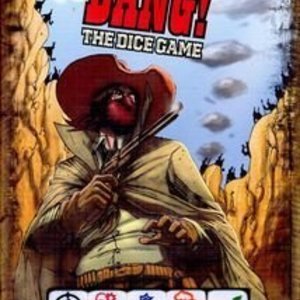
BANG! The Dice Game
Tabletop Game
In the U.S. wild west, the eternal battle between the law and the outlaws keeps heating up....
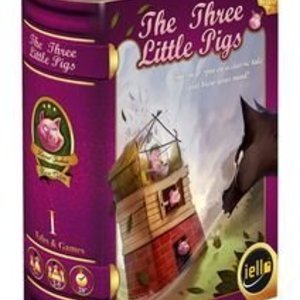
Tales & Games: The Three Little Pigs
Tabletop Game
As a little pig, your dearest wish is to build a strong and beautiful house in which you can spend...
